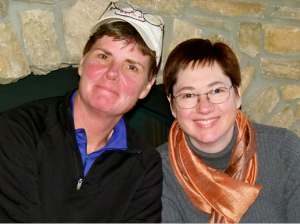Last month I had a great conversation with my friend Ellen Winiarczik about her strategic planning work with nonprofits. Our two worlds run parallel to each other most of the time; while my team and I are usually helping an organization find funding sources, Ellen deals more with making sure that a nonprofit is structurally strong, that the organization is prepared to meet its mission and that its board has a firm grip on the rudder. I asked Ellen to share a few words about her work and how our worlds collide (in a good way!) with each other.

Ellen and Helen
For 13 years I’ve run a firm that consults with nonprofits, foundations and government agencies, large and small, in strategic planning and implementation, resource investment, program evaluation, leadership and fund development as well as inclusive excellence. I just returned from a 12 day exchange visit with leaders of US nonprofit organizations visiting their counterparts in charities of all flavors in the Republic of Ireland and Northern Ireland. These visits that I lead every year are designed to create lasting relationships and learning opportunities amongst far-flung peers, and they’re always an enlightening and wonderful experience for all of us.
While our economy is showing small signs of recovery, it’s clear that an Irish banking collapse and an over-extended government calling for austerity measures means cut backs for everyone there, especially for nonprofits depending upon government programs and funding.
Every nonprofit organization no matter where you are needs to chart a steady course for their future. Those that are the strongest, even in difficult times, find ways to strategically engage board members, staff, volunteers and stakeholders to guide the organization’s future by making concrete goal-driven plans to ensure success.
They do this in part by sharing mission and operational clarity that spans across the organization at all levels. This phenomenon occurs when good communication exists, vertically and horizontally, and everyone is consulted about strategic plan creation and reasonable goal setting.
Strategic planning, according to BoardSource, the leading US information-sharing organization for nonprofit leadership, requires both thinkers and doers and must meet the needs of a wide variety of stakeholders. If [any] are left out of the process, the final plan tends to serve the needs of a few who may not be fully aware of the actual impact of their decisions. The BoardSource website goes on to outline the different roles for each of the key players in this equation.
Board members govern the organization and set policy as well as outline strategic organizational direction. Boards deal with multiple priorities including organizational governance, investment and spending policies, and programmatic direction. Clearly board members need to have a keen eye on ensuring that financial resources are always available to support key programs that carry out the organization’s mission.
Executive leadership provides the data necessary to inform the board and works in tandem with the board to craft reasonable (or even lofty!) strategic plans. Operational data includes specifics on all resources needed to run and sustain operations with enough in the bank for adverse situations (in a perfect world, 6-12 months). This information is optimally sourced from all departments and outlines an organization’s current direction with solid operational data to inform and support key growth opportunities.
With data in hand executive leadership and board members feel confident that they have all the right information to make key strategic planning decisions that includes anticipating how much money, personnel, and facilities are needed to support existing operations, and grow, if desired.
But what if an organization has key roles such as development (fundraising) that are not invited to participate in the process? In my experience, this happens all too often. Here’s where effective communications including relationship building and strategic outreach as well as a healthy dose of data to support the development office’s real or potential impact on the bottom line come in handy.
Sometimes, though, it’s simply a case of the board and executive leadership not being aware of development’s expertise. For example, I worked with a small organization on strategic planning a few years ago. This organization was embedded in a larger, higher education institution, but hadn’t engaged in conversation with the fundraising staff of the parent institution during their 5 year existence. While highly autonomous this small organization neglected to realize that they had larger institutional resources to leverage in securing future programmatic success. Once they forged those relationships, key funders were quickly identified and became engaged as supporters.
Steering a clear course in these economic times can be unnerving. Boards, CEOs, and fundraising staff have the opportunity to create a strong team with which to weather the storm together. As spring moves into summer it’s beginning to look like our economy may have some small squalls to navigate. Nonprofits need to stay true to their course and communicate across the organization to accomplish their strategic outcomes for stability and growth.
Ellen Winiarczyk is President of Win-ar-zic & Associates in Denver, CO. Her firm specializes in strategic planning, leadership development and evaluation for nonprofits and foundations. She is on LinkedIn at http://www.linkedin.com/in/ellenw.
